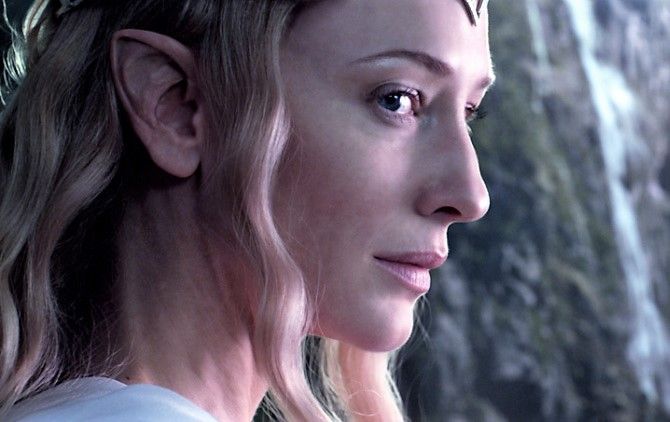Tolkien and his elves
.jpg)
The origin of J. R. R. Tolkien’s elves are as varied as the sources he knew and as unfathomable as imagination itself. Tolkien was a well-read medievalist; not surprisingly, he drew heavily from period primary sources. These, in turn, drew on actual folk traditions, although his elves were removed from pre-industrial folklore. One of the most obvious differences separating Tolkien's elves from folklore are those ears. Northern European folklore consistently describes people encountering elves - or whatever they are called in the local language - and not noticing anything strange about these entities. They seem like normal people. It is only after the story unfolds that the protagonist becomes aware that he - or she - is dealing with the supernatural. Tolkien's elves have ears that are dead giveaways, and in the Peter Jackson movies, hair styles are specifically designed to show off this peculiar feature. This is not something one would find in pre-industrial folklore.
In addition, elves in tradition are fleeting. There are encounters with them, but most of all, elves resent being spied upon and prefer to exist apart from humanity. They occasionally seek to capture a human - young women and baby boys being preferred - but anyone who sought them out would either find nothing or they would receive a dreadful punishment. Tolkien needed to work around this feature of folklore if his elves were to play a significant role in his stories. His solution in The Hobbit (1937) initially held true to folklore: the elusive elves of Mirkwood capture much of the "feel" of folklore. The final battle that included an army of elves exhibits an epic quality that would have an alien to a folk legend or a folktale, but in general, Tolkien managed the motif in a way that clung closely to the inspiration in oral tradition. In The Lord of the Rings (1954-1955), Tolkien's elves are more in the forefront, yet another step removed from folklore.
![ae1c760c1264270bc0443b8f68baa288--fantasy-art-lord-of-the-rings[1].jpg](https://steemitimages.com/640x0/https://steemitimages.com/DQmPuQd9eGvC1P5fViShGbmoWVEAsBqkmFZ5r79gNs8HD3S/ae1c760c1264270bc0443b8f68baa288--fantasy-art-lord-of-the-rings%5B1%5D.jpg)
One of the more important deviations that Tolkien imposed on the world of his creation was the idea of good and evil, which was largely absent from Northern European folk tradition. The dichotomy was a Church-based importation, and the folk were not quick to embrace it. Tolkien, perhaps because he was a committed Catholic but perhaps also for the facility of his concept of plot and literature, embraced the good-versus-evil approach to his world, and this required some "tweaking" of the legendary traditions that served as his inspiration.
Although Icelandic sources include an odd reference to light and dark elves, there is no clear manifestation of such a concept in pre-modern Scandinavian, Icelandic, or British and Irish tradition. Nevertheless, Tolkien - drawing on this or simply setting off on his own - created a dichotomy where his elves were good and their counterpart, the orcs, played the role that one might imagine could have been assumed by "dark elves." In reality, folk traditions regarded all supernatural beings a dangerous even though most were neither good nor evil. They were to be treated with caution and respect, and they were to be avoided if at all possible.
![the-lord-of-the-rings-john-ronald-reuel-tolkien-silmarillion-middle-earth-elven-realms-rivendell-imladris-liv-tyler-arwen-undomiel-prince[1].jpg](https://steemitimages.com/DQmSZDGVXpTpic9NTo49FywZnscUurPkSmr5wwMLFDEhxYh/the-lord-of-the-rings-john-ronald-reuel-tolkien-silmarillion-middle-earth-elven-realms-rivendell-imladris-liv-tyler-arwen-undomiel-prince%5B1%5D.jpg)
There is a motif from medieval literature, with limited connections to folklore, that Tolkien exploited in a profound way. This describes a love affair between a human and an elf. Relations could involve either a man or a woman, but Tolkien's preoccupation was with the human suitor of an elfin maiden. With these stories, Tolkien stays close to the inspiration in the primary source literature, even thought the folklore counterpart would not have taken the motif as far. Nowhere is this truer than in Tolkien's story of Beren and Lúthien. Here, he is able to capture the tragic aspects inherent in these relationships. The author/medievalist is, perhaps, at his finest as he explores the poignant, ill-fated nature that underpinned any effort to cross the boundary separating humanity and faerie, all in the name of love.
![9781328791825_hres-678x1024[1].jpg](https://steemitimages.com/640x0/https://steemitimages.com/DQmZ6gF3CPuA5AuLVdYd43VF3p1LNnTy6EK1hqd1gnGX5Lm/9781328791825_hres-678x1024%5B1%5D.jpg)